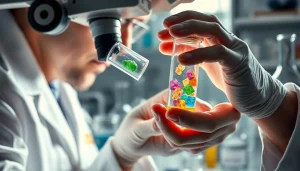A Comprehensive Overview of Synthetic Cannabinoids
In recent years, there has been a marked increase in the use and availability of Synthetic Cannabinoids, chemical substances that are man-made in laboratories. They are designed to mimic the effects of natural cannabinoids found in cannabis plants. However, despite their intended purpose, these substances can lead to significant health risks and unpredictable effects. This article will serve as a comprehensive resource to understand synthetic cannabinoids, their production, legal status, health effects, and ongoing research endeavors.
What Are Synthetic Cannabinoids?
Synthetic cannabinoids, also known as synthetic cannabis, are a class of psychoactive substances that bind to cannabinoid receptors in the brain and body. They were initially developed for research purposes, to study the endocannabinoid system and its role in human physiology. Unlike naturally occurring cannabinoids like THC (tetrahydrocannabinol) and CBD (cannabidiol), synthetic cannabinoids are chemically engineered to produce a similar, but often more intense effect.
These substances are often marketed under brand names such as “Spice” or “K2” and can be found in products that are commonly sold as “herbal incense” or “legal highs.” Unfortunately, the formulations can vary significantly, resulting in unpredictable pharmacological effects. Furthermore, there are hundreds of different types of synthetic cannabinoids, which means users often encounter substances with unknown safety profiles.
How Synthetic Cannabinoids Are Made
The manufacturing of synthetic cannabinoids involves complex chemical processes. These substances are synthesized in laboratories by modifying the molecular structure of existing cannabinoids or creating new compounds that can interact with the body’s cannabinoid receptors. Common synthetic cannabinoids include compounds such as JWH-018, HU-210, and AB-CHMINACA, which represent merely a fraction of the numerous forms available.
Manufacturers often change the chemical structure of these releases to circumvent legal restrictions. Consequently, many of these substances have not been extensively studied, raising concerns regarding their safety and potential for abuse. Moreover, illicit labs sometimes produce synthetic cannabinoids without adhering to the same safety or quality control standards as legitimate pharmaceutical manufacturing practices, further contributing to potential health risks.
Legal Status of Synthetic Cannabinoids
The legal status of synthetic cannabinoids is complex and varies by region. In many countries, certain synthetic cannabinoids have been classified as controlled substances, effectively prohibiting their sale and use. In the United States, for instance, several synthetic cannabinoids have been placed under the schedule I classification of the Controlled Substances Act. This classification suggests that these substances possess a high potential for abuse and have no accepted medical use.
Despite these regulations, the continued emergence of new synthetic cannabinoids—often intended to mimic the effects of banned substances—has led to a cat-and-mouse game between law enforcement and manufacturers. New variants can be created and sold often before legal action can be taken, which highlights the challenges associated with regulating synthetic drugs.
Health Effects and Risks Associated with Synthetic Cannabinoids
Short-Term Effects of Synthetic Cannabinoids
The short-term effects of synthetic cannabinoids can vary dramatically from user to user, largely depending on the specific compound consumed, dosage, and the individual’s physiological makeup. Common immediate effects may include heightened mood, relaxation, altered perception, and increased heart rate. However, these substances can also lead to severe adverse reactions.
Users have reported anxiety, paranoia, hallucinations, and aggression after consuming synthetic cannabinoids. Emergency room visits linked to their use often involve symptoms that far exceed those associated with natural cannabis, warranting immediate medical attention.
Long-Term Health Implications
The long-term health effects of synthetic cannabinoids are less understood due to a lack of extensive clinical studies. However, anecdotal evidence and case studies indicate that these substances could lead to serious health complications over time. Users may experience psychological dependence, which can cultivate an ongoing cycle of use and potential addiction.
There is also some evidence to suggest that chronic use may affect cognitive functions and mental health, as well as exacerbating existing psychiatric conditions. Furthermore, long-term users have reported various health issues, such as kidney damage, seizures, and severe withdrawal symptoms when attempting to stop use, mimicking symptoms associated with other forms of substance use disorders.
Emergency Responses to Adverse Reactions
Given the unpredictable nature of synthetic cannabinoids, managing adverse effects can require specialized medical interventions. In emergencies, healthcare providers should perform immediate assessments and provide supportive care. Treatment may include detoxification measures for users experiencing physical difficulties, such as agitation, vomiting, and seizures.
Public health initiatives are increasingly focusing on education, prevention, and the importance of seeking medical attention when synthetic cannabinoid use leads to concerning symptoms. Awareness campaigns can help inform potential users about the risks and encourage safer behaviors or harm reduction approaches if they choose to engage with these substances.
Comparing Synthetic Cannabinoids to Natural Cannabinoids
Mechanism of Action in the Body
Both synthetic and natural cannabinoids operate primarily by interacting with the body’s endocannabinoid system (ECS), which plays a critical role in regulating a variety of physiological processes, including mood, memory, appetite, and pain sensation. The ECS consists of cannabinoid receptors (CB1 and CB2), endogenous cannabinoids, and metabolic enzymes.
While natural cannabinoids like THC and CBD engage with these receptors in a manner that is generally well understood, synthetic cannabinoids can have much stronger, and sometimes unpredictable, affinities for these receptors. This potent interaction can lead to effects that far surpass those of natural substances, which is why users often find synthetic counterparts more intoxicating but also riskier.
Comparative Health Risks
The health risks associated with synthetic cannabinoids are substantially greater compared to natural cannabinoids. While natural cannabis has been studied extensively with a comparatively favorable safety profile, synthetic cannabinoids often originate from unregulated sources and can vary wildly in potency and chemical composition. Consequently, adverse effects are frequently reported, and the incidence of serious health problems is much higher with synthetic forms.
Furthermore, the added synthetic chemicals can lead to additional toxic effects that are rarely seen with natural cannabinoids. For example, some synthetic analogs can cause respiratory failure, extreme agitation, and even death, whereas natural cannabis products tend to have a relatively mild overdose profile.
User Experiences: Testimonials and Research Studies
User testimonials often illustrate the stark differences in the experiences associated with synthetic and natural cannabinoids. Many users have reported enjoying the euphoric effects of cannabis but express regret or fear when it comes to synthetic products due to the unpredictable and often distressing side effects.
Research studies reveal similar trends. While some users of synthetic cannabinoids report initial euphoria, the negative psychological reactions have been substantial enough to lead to calls for more comprehensive regulations and increased public awareness. Despite a minority of users claiming positive experiences, the overwhelming consensus among healthcare professionals is that the risks associated with synthetic cannabinoids outweigh any perceived benefits.
Current Research Trends in Synthetic Cannabinoids
Ongoing Studies on Safety and Toxicity
Research into the safety and toxicity of synthetic cannabinoids is ongoing. Scientists are actively working to elucidate the mechanisms that contribute to the potentially severe effects observed in users and to identify which compounds are the most harmful. Laboratory studies are employing animal models to better understand the neurotoxic impact of synthetic cannabinoids.
Additionally, researchers are investigating the pharmacokinetics and pharmacodynamics of various synthetic cannabinoids. By examining how these chemicals are absorbed, distributed, metabolized, and excreted by the body, scientists can better assess their risks and develop public health strategies to address their use.
Innovations in Synthetic Cannabinoid Development
Innovations in the field of synthetic cannabinoids include the development of new substances that may exhibit a variety of effects and potencies. Researchers are exploring new synthetic analogs with potential therapeutic benefits that could be safer alternatives to traditional pharmaceutical options.
However, the challenge remains to strike a balance between beneficial applications and potential abuse. Safeguards must be instituted during the research and development stage to prevent adverse consequences among users. Scientists aim to ensure that any new synthetic cannabinoids undergo rigorous testing to establish their safety and efficacy.
Future Directions for Research and Regulation
Future research in synthetic cannabinoids is likely to focus on understanding their long-term effects, developing better safety assessments, and improving regulatory practices. As new synthetic cannabinoids continue to emerge, continuous monitoring and responsive regulatory frameworks will be essential in protecting public health.
Furthermore, there is a pressing need for education among healthcare providers, users, and the general public regarding the risks associated with both existing and emerging synthetic cannabinoids. Increased awareness can help mitigate harmful effects and promote responsible behavior if individuals choose to use these substances.
Educational Resources and Support for Synthetic Cannabinoid Issues
Where to Find Reliable Information
With the complexities surrounding synthetic cannabinoids, it is essential for users and concerned individuals to have access to reliable information. Reputable healthcare organizations and educational institutions often provide up-to-date resources about synthetic cannabinoids, their implications, and harm reduction strategies.
Websites like the National Institute on Drug Abuse (NIDA) and various addiction recovery organizations offer valuable data and insights that can aid in making informed decisions. It is critical to seek out credible and scientifically-based sources when researching synthetic cannabinoids.
Support Networks for Users and Families
Families affected by synthetic cannabinoid use or dependency may benefit from connecting with support networks that focus on addiction and recovery. Various charities and organizations provide forums for individuals to share experiences, receive counseling, and access treatment resources geared towards substance abuse.
Engaging with these networks can provide much-needed emotional support and practical advice for both users and their families. Peer support groups can play a crucial role in navigating recovery, helping users share their challenges and triumphs.
Professional Guidance and Intervention Strategies
Individuals struggling with synthetic cannabinoid dependency are encouraged to seek professional guidance. Integrated treatment approaches that consider both psychological and physiological aspects provide the most effective avenues for recovery.
Healthcare professionals can implement tailored intervention strategies, which might include cognitive behavioral therapy, addiction counseling, and medical supervision during the detox process to ensure a safer recovery experience. The journey to recovery is unique for every individual, and accessing professional help is critical in navigating this complex landscape.


